Chapter: 11th Physics : UNIT 11 : Waves
Interference of waves
Interference of waves
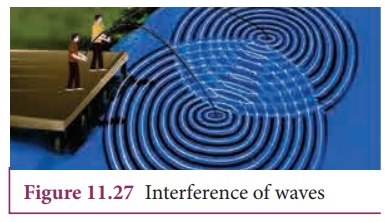
Interference is a phenomenon in which two waves superimpose to form a resultant wave of greater, lower or the same amplitude.
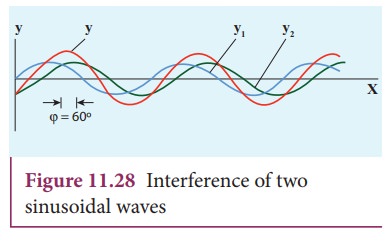
Consider two harmonic waves having identical frequencies, constant phase difference φ and same wave form (can be treated as coherent source), but having amplitudes A1 and A2, then

Suppose they move simultaneously in a particular direction, then interference occurs (i.e., overlap of these two waves). Mathematically

Therefore, substituting equation (11.47) and equation (11.48) in equation (11.49), we get
y = A1 sin(kx − ωt) + A2 sin(kx − ωt + φ)
Using trigonometric identity sin (α+β) = (sin α cosβ + cosα sinβ ), we get
y = A1 sin(kx − ωt)+A2 [sin(kx − ωt) cosφ + cos(kx − ωt) sinφ]

then equation (11.50) can be rewritten as y = A sin(kx−ωt) cosθ + A cos(kx−ωt) sinθ
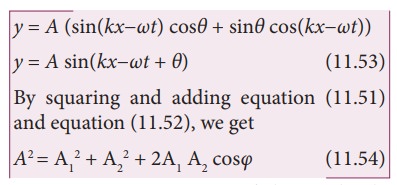
Since, intensity is square of the amplitude (I = A2), we have

This means the resultant intensity at any point depends on the phase difference at that point.
(a) For constructive interference:
When crests of one wave overlap with crests of another wave, their amplitudes will add up and we get constructive interference. The resultant wave has a larger amplitude than the individual waves as shown in Figure 11.29 (a).
The constructive interference at a point occurs if there is maximum intensity at that point, which means that
cosφ = + 1 ⇒ φ = 0, 2π,4π,… = 2nπ,
where n = 0,1,2,...
This is the phase difference in which two waves overlap to give constructive interference.
Therefore, for this resultant wave,

Hence, the resultant amplitude
A= A1 + A2
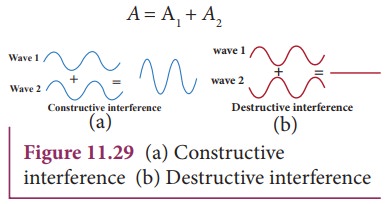
(b) For destructive interference:
When the trough of one wave overlaps with the crest of another wave, their amplitudes “cancel” each other and we get destructive interference as shown in Figure 11.29 (b). The resultant amplitude is nearly zero. The destructive interference occurs if there is minimum intensity at that point, which means cosφ = − 1 ⇒ φ = π,3π,5π,… = (2 n-1) π, where n = 0,1,2,…. i.e. This is the phase difference in which two waves overlap to give destructive interference. Therefore,

Hence, the resultant amplitude
A=|A1−A2|
Let us consider a simple instrument to demonstrate the interference of sound waves as shown in Figure 11.30.
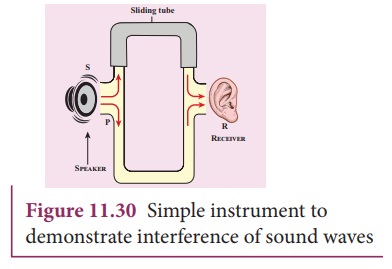
A sound wave from a loudspeaker S is sent through the tube P. This looks like a T-shaped junction. In this case, half of the sound energy is sent in one direction and the remaining half is sent in the opposite direction. Therefore, the sound waves that reach the receiver R can travel along either of two paths. The distance covered by the sound wave along any path from the speaker to receiver is called the path length . From the Figure 11.30, we notice that the lower path length is fixed but the upper path length can be varied by sliding the upper tube i.e., is varied. The difference in path length is known as path difference,
![]()
![]() ∆r = |r2 − r1|
∆r = |r2 − r1|
Suppose the path difference is allowed to be either zero or some integer (or integral) multiple of wavelength λ. Mathematically, we have
∆r = nλ where, n = 0, 1, 2, 3,....
Then the two waves arriving from the paths r1 and r2 reach the receiver at any instant are in phase (the phase difference is 0° or 2π) and interfere constructively as shown in Figure 11.31.

Therefore, in this case, maximum sound intensity is detected by the receiver. If the path difference is some half-odd-integer (or half-integral) multiple of wavelength λ, mathematically, Δ r = n(λ/2)
where, n = 1,3,... (n is odd)
then the two waves arriving from the paths r1 and r2 and reaching the receiver at any instant are out of phase (phase difference of π or 180°). They interfere destructively as shown in Figure 11.32. They will cancel each other.
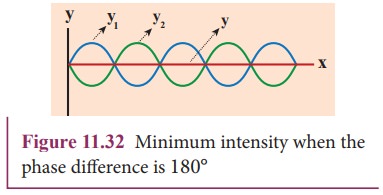
Therefore, the amplitude is minimum or zero amplitude which means no sound. No sound intensity is detected by the receiver in this case. The relation between path difference and phase difference is

EXAMPLE 11.16
Consider two sources A and B as shown in the figure below. Let the two sources emit simple harmonic waves of same frequency but of different amplitudes, and both are in phase (same phase). Let O be any point equidistant from A and B as shown in the figure. Calculate the intensity at points O, Y and X. (X and Y’ are not equidistant from A & B)

Solution
The distance between OA and OB are the same and hence, the waves starting from A and B reach O after covering equal distances (equal path lengths). Thus, the path difference between two waves at O is zero.
OA − OB = 0
Since the waves are in the same phase, at the point O, the phase difference between two waves is also zero. Thus, the resultant intensity at the point O is maximum.
Consider a point Y, such that the path difference between two waves is λ. Then the phase difference at Y is

Therefore, at the point Y, the two waves from A and B are in phase, hence, the intensity will be maximum.
Consider a point X, and let the path difference the between two waves be λ/2.
Then the phase difference at X is

Therefore, at the point X, the waves meet and are in out of phase, Hence, due to destructive interference, the intensity will be minimum.
EXAMPLE 11.17
Two speakers C and E are placed 5 m apart and are driven by the same source. Let a man stand at A which is 10 m away from the mid point O of C and E. The man walks towards the point O which is at 1 m (parallel to OC) as shown in the figure. He receives the first minimum in sound intensity at B. Then calculate the frequency of the source.
(Assume speed of sound = 343 m s-1)

Solution
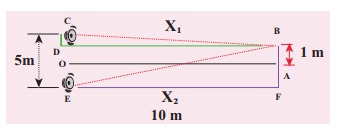
The first minimum occurs when the two waves reaching the point B are 180° (out of phase). The path difference ∆x = λ/2.
In order to calculate the path difference, we have to find the path lengths x1 and x2.
In a right triangle BDC,
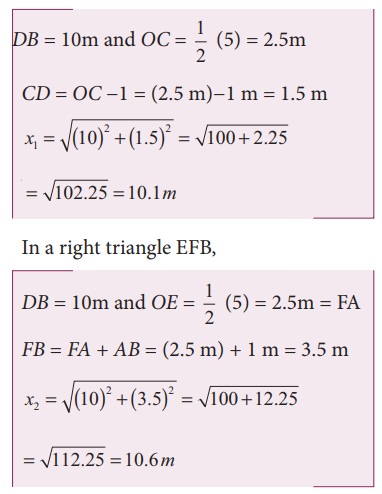
The path difference ∆x = x2 − x1 = 10.6 m−10.1 m = 0.5 m. Required that this path difference
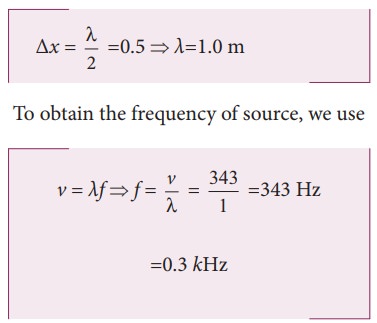
Related Topics